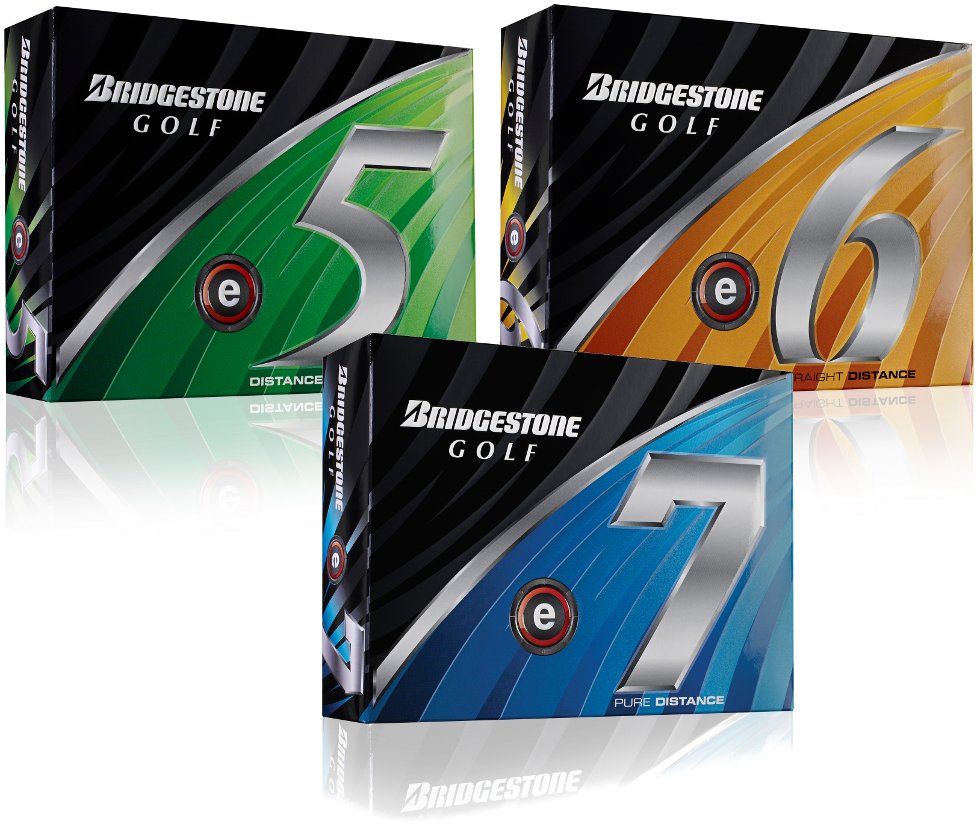 First released back in 2005, the e-Series balls from Bridgestone set out to help the amateur that was looking for the boost in distance that the softer balls couldn’t provide. Throughout the last few years, the e-Series balls have been tweaked and polished
First released back in 2005, the e-Series balls from Bridgestone set out to help the amateur that was looking for the boost in distance that the softer balls couldn’t provide. Throughout the last few years, the e-Series balls have been tweaked and polished
While some golfers remained unquestionably (and almost illogically) loyal to the offerings of competitors, little by little, more and more amateur players have gravitated to the e-Series (as well as other Bridgestone products) and now sing the praises, wishing they had switched sooner. Bridgestone only added fuel to the fire, offering public ball fittings available to anyone and everyone looking to find the ball to fit their game to the greatest degree possible.
I had a little question to ask myself when reviewing these balls, and that was exactly what approach to take because the e-Series is aimed squarely at the everyday player with amateur swing speeds. Problem is that my swing speed is well above that of the average amateur (my scores are a result of me basically sucking, falling back into old habits, and making poor decisions, plain and simple :-D).
Design and Technology
All utilize Bridgestone’s proprietary Dual Dimple Technology, which is said to maximize distance, optimize aerodynamics at launch and during descent. The inside dimple is now deeper, increases thrust power at launch. The exterior dimple promotes shallower landing angle for more rollout.
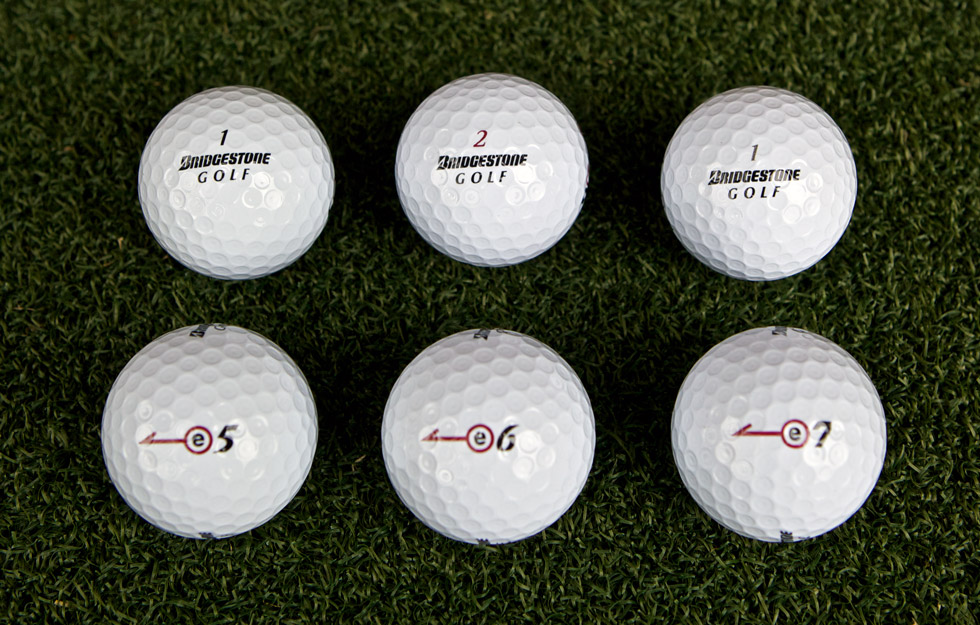
e5
First out the gate is the updated e5, which employs a two-piece construction consisting of a urethane cover and a larger gradational core. The e5 is the answer to players with moderate swing speeds that want “the ultimate in soft feel and spin around the greens” as well as a boost in distance. The previously mentioned gradational compression core and urethane cover were combined to produce exactly that. The cover features Bridgestone’s Dual Dimple Technology, which also helps in the distance department. The cover is stamped with the familiar Bridgestone logo as well as an alignment line that is useful to some when lining up putts. As a side note, the e5 was a recent winner of a gold medal in Golf Digest’s Hot List.
e6
Next up is the also new and improved e6. As opposed to the e5, the e6 goes with a three-piece design, using a Surlyn cover, a side-spin combating inner layer, and a soft gradational compression core. According to Bridgestone, the e6 is the softest multi-layer ball on the market right now. Not only that, it also holds the distinction of being the lowest compression multi-layer ball available. What this means is that this ball will work very well for players with a moderate swing speeds. The anti-sidespin inner layer is key here, and has contributed to the e6 becoming Bridgestone’s most popular ball in the e-Series. Again we find the cover featuring not only the 330 (dual) dimple technology, the e5 also displays identical markings to the other two balls in the e-Series, of course with the exception of it being stamped with it’s name instead of e5 or e7. There are a total of three color options, including standard white, as well as optic yellow and optic orange.
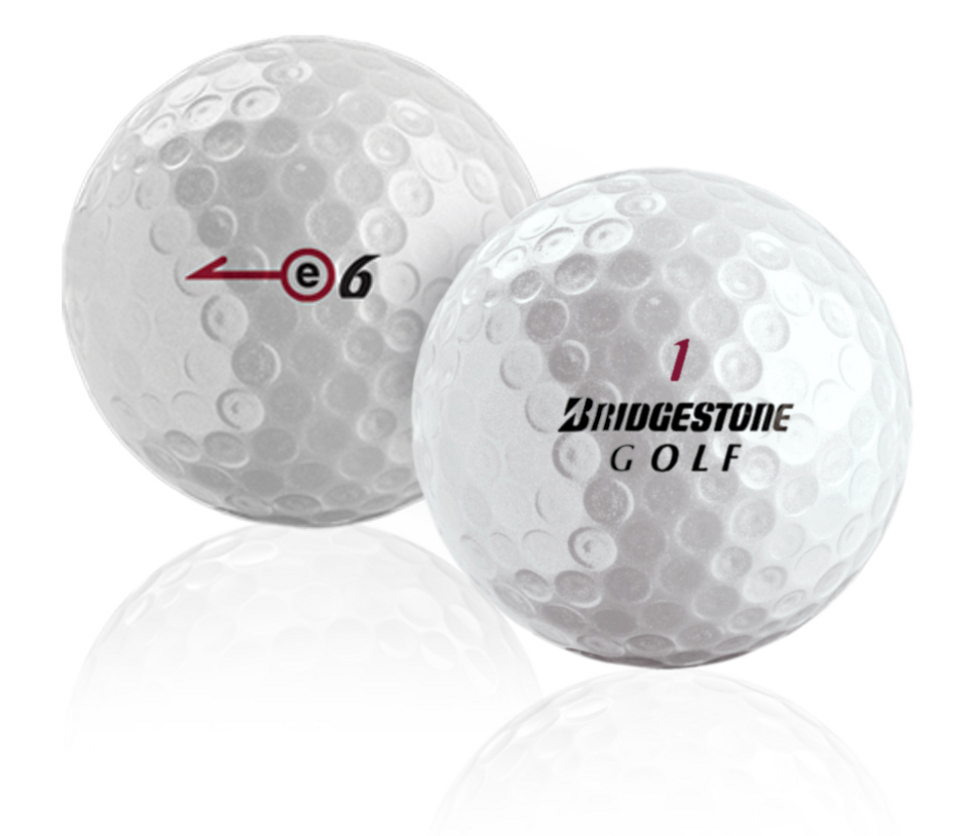
e7
If you don’t have a need for a ball that combats side spin, but you are looking for pure distance in a multi-layer ball, the e7 is the ball you’re looking for in this series. Its purpose is plain and simple – produce as pure of distance as possible on all shots, from driver down through wedges. Featuring a three-piece construction and high-speed gradational core, the e7 also goes with the Surlyn cover though this ball goes with velocity boosting technology in its core and is geared to produce a more penetrating ball flight. Again we find 330 dimples in the cover, using the new Dual Dimple Technology along with similar stamping and alignment lines.
Bridgestone has long been an industry pioneer in golf ball aerodynamics, as evidenced by its invention of Seamless Cover Technology, so it should be no surprise that the improvements to the 2011 e-Series rest squarely in the balls’ aerodynamics. Our engineers have used their extensive knowledge in that area, and information gathered from our nearly 100,000 live consumer ball-fittings to identify target areas of improvement for the new designs. Across the board, we found that consumers were always looking for more distance. Our new Dual Dimple Technology, the first technology to make use of different areas of the dimple at launch and during descent, has allowed us to achieve more distance without sacrificing any of the ball flight help for which the e-Series has become known.
Brandon Sowell, Director of Marketing – Bridgestone Golf, Inc.
Distance
For starters, the e5, e6, and e7 were all very long – as long as any ball I’ve ever played, if not longer. I’d really like to have hardcore performance data (spin rates, average distance per ball, etc.) but I don’t have a launch monitor available. Really though, it’s not all that necessary as it’s pretty easy to tell how they perform especially when testing on the same course, as you know where you normally are off the tee on most holes.
I took the approach for testing all three balls as this – pay attention to which ball I’m hitting, but don’t look at the boxes/PR/intentions of the ball until I’m done testing (so that I’d have no pre-conceived notions on what the ball is supposed to do.
e5
While I didn’t find it quite as long as the other two in this family, the e5 certainly still performs beautifully off the tee and I still believe it’s one of the longer balls on the market. I think part of what separates it from the e6 and e7 is that it lands a little bit softer and doesn’t roll out quite as much. Still, it flies very long and true, with a great feel at impact (which we’ll get to in a bit).
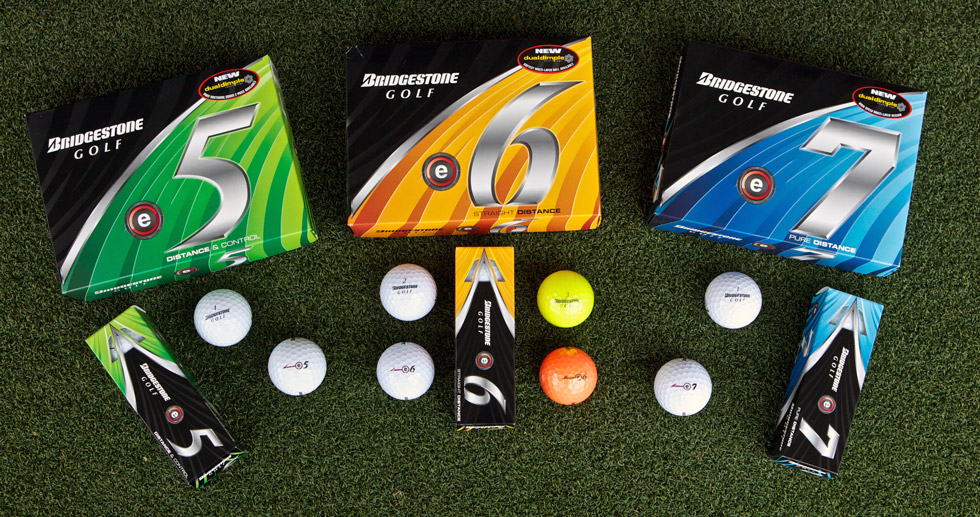
I’d recommend the e5 to someone looking for a ball that offers little boost in distance but maintains a soft feel and the ability to really stick a shot. I’m not going to tell you it adds a 20-yard gain in distance (because it will be different for everyone, obviously), but I will tell you that it will be a noticeable difference, regardless of the type of player you are.
e6
The e6 was a bit of an enigma for me at first in that it took me a few swings to figure it out. First I should say, it definitely does what it says – any intended side spin was at the very least reduced for me. The problem is that there are times I’d actually like a bit of side spin – specifically off the tee. My stock shot with the driver is one of three, either straight, slight push, or push draw, but for the most part, I don’t have a problem with a slice. Where that became an issue was when I’d try to hit that push draw. There are a couple of particular holes at my home course that call for it. So when that push draw ended up being a flat push (remember, a push or pull isn’t a result of side spin like a hook and a slice are). It seemed like the ball was trying to draw back left, but never really came back as much as I’m used to. Of course, had I paid attention to what the ball was supposed to do (reduce side spin) prior to hitting it, I probably would have taken something shorter than driver off the tee or approached the hole differently. I don’t necessarily look at that as a negative though – the ball did what it says. Remember, it won’t stop you from pushing or pulling, and I wouldn’t rely on it to cure a severe slice/hook (lessons, practice, rinse, repeat), but the e6 will make them less severe.
As far as distance goes, there are zero complaints, and I can see how that reduction in side spin leading to many being much further down the fairway. I found the e6 to be just as long as anything else I’ve ever played. The Dual Dimple Technology came into play off the tee especially, as the ball did roll out quite a bit more as advertised.
e7
Like the other two, the e7 works as advertised. Maybe better. I found it to be crazy long, especially off the tee. Iron shots were crisp, but again, there were a few times when I was in between clubs, so naturally, I choked down, and still ended up being a bit long of my target. I’m not complaining though, in fact, when faced with an in-between yardage, that prompted me to start to favor the shorter iron (which normally equates to less or no roll out). I’ll never complain about that!
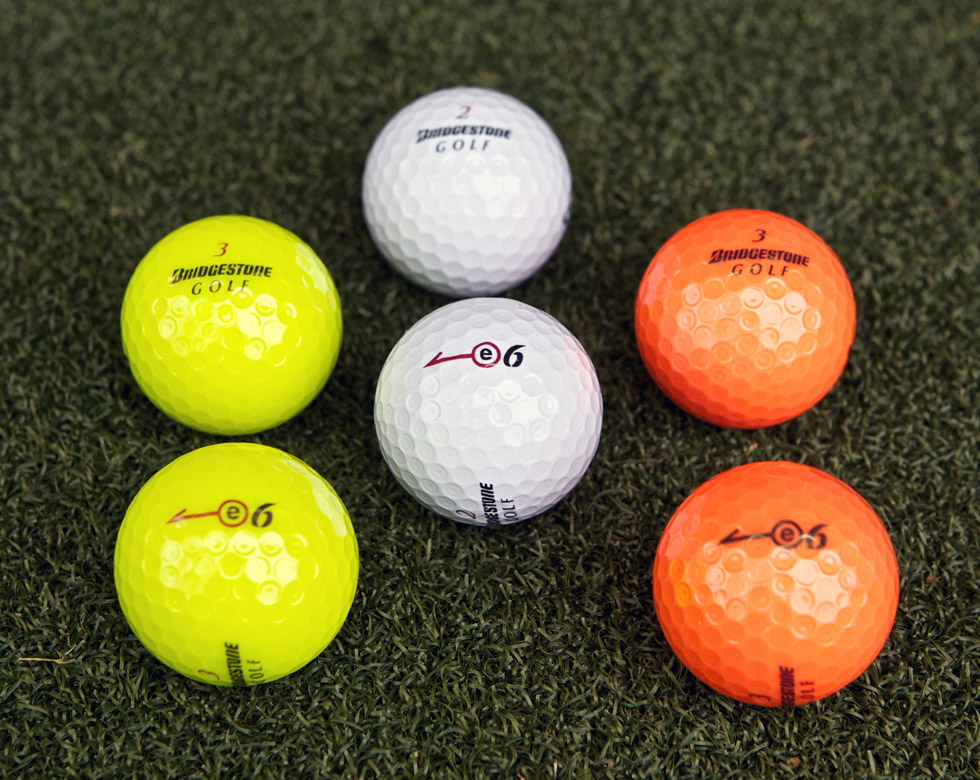
In the same situations mentioned in the e6 distance section, where I normally play a push draw, using the e7, that soft draw returned. Now, remember that if you are fighting side spin in either direction, this probably isn’t the ball for you. If a bit of working the ball is part of your game however, the e7 will give you that plus an abundance of distance. Again, the shallower angle of descent, thanks to the Dual Dimple Tech, shined as the ball rolled out quite a bit. The e7 flew a hair lower than normal for me, though if I wasn’t actively paying attention for the specifics of the trajectory, I don’t think I would have noticed it. Though I didn’t get the opportunity to test this theory, I’ve got a feeling this ball performs very well in windy conditions due to the fact that it spins less (I’ll get to that further down) and won’t balloon, plus the lower angle of decent should keep it under the wind a little more.
Feel and Spin
e5
In terms of feel, I was a little shocked when I hit the e5. Right or wrong, I normally equate a two-piece ball with a harsh, rock-like feel. That really wasn’t the case with the e5. Somehow, they felt as good as most three piece balls out there. I mean that statement across the board, from off the tee with a driver or fairway, all the way down to those half wedge shots, and even off the face of the putter. I’m not going to mention any names, but I’ll just say that I didn’t find the e5 to be quite as soft as some of the upper tier balls (as in the balls you pay $40+ per box for), but it’s definitely softer than most in its category, which I attribute to the urethane cover.
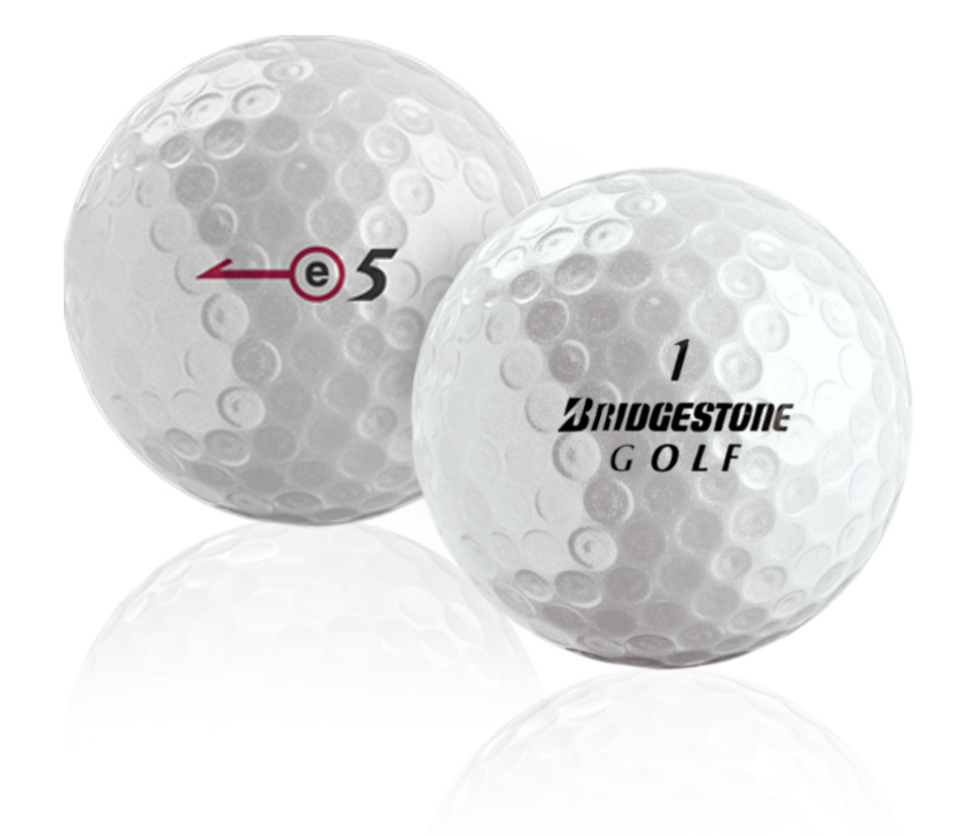
As for spin, the e5 performed pretty well, actually better than I expected, which is also likely attributed to the softer urethane cover. Full swings with the short irons would either sit down immediately, or roll just a few inches. From 80 yards and in, it may have rolled out just a little bit more than I would have liked, but again, when compared to other two piece balls in this price range, I felt like it was superior to others I’ve tried. Don’t get me wrong, I’m not meaning it would roll out yards past where it would land, just maybe a few feet past what I’m used to.
e6
I found the feel of the e6 to be best described as solid. Not close to being harsh or rock hard, but not as soft as a more expensive multi-piece tour level ball. The difference in feel on short chips and putts is negligible compared to the e5 and e7. Even on half-wedge pitches, I didn’t feel like it was much harder than the e5. On full swings, with irons fairway woods, and the driver, it was a bit softer, and I’m guessing that’s from the inner anti-side spin layer and core being activated. In fact, I’d guess that the softer inner layers make the ball easier to compress which is going to benefit players with slower to moderate swing speeds.
As for spin, while it’s not the spinniest ball ever, it definitely does okay. For the most part, I hit the ball pretty high, especially with my irons, so usually anything I hit doesn’t go far after it hits the ground. I also don’t think many people will be sucking it back off the green with their wedges anytime soon, but it’s also not going to roll out forward excessively either. If you’ll think back to the description of the Dual Dimple Technology, it says that the outer dimple promotes a shallow angle of descent for increased roll, and while I experienced that off the driver, I didn’t really see it off the irons (not that that’s a bad thing). Remember though, as I said, I usually hit the ball fairly high, so if your ball flight has more of a lower trajectory, or if you don’t normally put a lot of spin on the ball, you may want to check out a sleeve before you go all in. Or just go to one of Bridgestone’s ball fittings 🙂 If you want a ball that doesn’t spin as much as one of the super soft tour balls, I suggest trying the e6 out.
e7
Of the three, if I had to say one was the least soft, I though it was the e7. Again, like the e6, don’t confuse harder with a harsh feeling, as it certainly was no where near unpleasant. In fact, when putting and chipping, I felt as if there was no difference in feeling at all between it and the e6. I only felt there was a difference on full swings, and even then, it wasn’t a night and day difference. I do feel like the e5 and e6 both came in just a little softer all around however, and I imagine that is the result of the surlyn cover used by the e6/e7 opposed to the softer urethane on the e5.
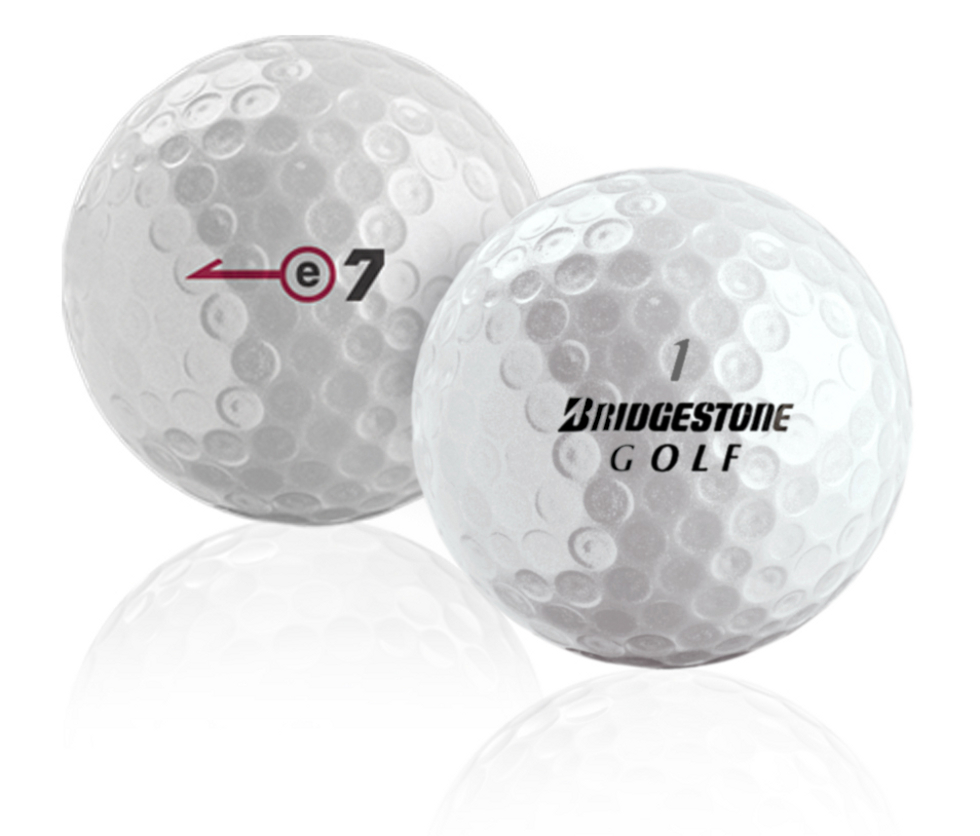
As far as spin goes, I found it to be pretty comparable to the e6 though it seems to fly just a bit lower, telling me maybe it doesn’t spin quite as much. Again, this wasn’t an issue on full swing approach shots, though 80-yards and in, depending on how you pitch the ball, it may roll out just a bit more than the e6. I never saw it as a problem though, and still was very satisfactory.
Durability
I’ve always thought about durability with the mindset that no news is good news: if a ball shreds quickly, you’ll hear someone complain about it, but if it holds its form for quite a while, you usually don’t hear a word about it. In the case of all three of these balls, you wouldn’t normally hear a word about the durability. It simply never became an issue for any of the three, throughout multiple rounds (and short game practice) over the last few weeks.
While most current balls, premium or otherwise, don’t have a problem in this category, it’s good to know that all balls in the e-Series should easily last a full 18 holes, if not longer. While I’d love to say I had one that lasted 36 or more, I may or may not have donated one or two to the water. Let’s just keep that between you and me though. If I had to guess, the e6 and e7 will outlast the e5, solely because of the cover material, but I really had no experience to back that up. Again, I’m just basing that on the cover material. Still, after numerous wedge shots, and maybe a skip or two off the cart path, I can confidently say that all three of them will last you for quite a while.
Random notes: First off, as they say, beauty is skin deep. The dual dimple tech makes the balls look a little strange. Nothing you’d notice at address, but it’s definitely noticeable up close.
Conclusion
When reviewing a great product, it’s easy to draw up a nice, neat conclusion and the Bridgestone e-Series ball definitely fall into that category. Do they work as advertised? No, they’re actually better than advertised. All three are ridiculously long, and I can’t imagine someone needing a distance boost not trying at very least one of the e-Series balls. At the very least, the performance you get at this price point (roughly $27 per dozen) makes them all at least worthy of a demo by nearly anyone short of a scratch golfer. You might walk away deciding you’re sticking with your current ball for whatever reason, but there’s no way you can deny how well they perform in terms of length.
Sure, the e6 and e7 aren’t the softest balls around the green, but they’re also not supposed to be. They are however much more than adequate. The e5 definitely meets that need though, if that softness is among your top priorities.

Bridgestone has done a really job designing and marketing their balls. I really like the e5 for its performance characteristics. The ball does feel a bit hollow or light off the clubface, but it’s a great ball for the price.
I have been playing the previous e5 for about a year now, sometimes I like the spin and sometimes I really hate the spin (Same with the Pro V1)….. great around the green, but a bit too much sidespin from the tee for me ….. I have also been experimenting with the 330 series ….., but I really like the new e6 !
I bought a box of e6’s but having read the review above I think I’ve bought the l e6’s as they’re single dimple, not dimple in dimple. Either that or the uk uses a different type of e6.
In either event they’re just an average ball to me, albeit one I can use for those “oh crap, my tee shots aren’t going straight” days. 🙁
Perfect review, I agree with everything said, a very good job. I play e6 yellow ones and they are on the par with yellow Srixons Z stars. Good balls.
I love the e6 balls, they wont cure your slice, but they’ll definitely help reduce it.
I picked up a sleeve of the e6 balls just to give them a shot and I was easily one to two irons longer with the ball. I flew the first 4 greens until I figured out what was going on. The ball takes off dead and high like a flyer lie for me. If all I wanted was distance it would be a great ball but, other than that I wasn’t impressed with green side performance
Thought I would weigh in on E series and especially the E6 for those that are considering giving them a try…..I am a 7 hdcp and have tried all the e Series balls and am a loyal e6 player; just converted a buddy of mine that was playing a higher priced 4 piece ball to the e6 also. fyi – My swing speed with driver is ~94 and to me, the e6 is the softest feeling of all the e series balls off every club in the bag including the putter. I switched to the e6 series back in 2008 as it was recommended to me to help lower the spin rate on my driver..I hit the ball fairly straight but I have a steep angle of attack so I produce too much spin with my Driver… At this point I play the E6 primarily for feel; I haven’t found it to add massive distance to my shots…and make no mistake if you make bad swing you can slice or hook it…but it may take most of that tail off your little cut/fade, or baby draw. I have zero problem stopping it on the green with a full shot (wont back-up) , although it does roll-out a bit on short shots around the green: but I’m more of a bump and run style player so that is not a big problem for me on the courses I frequent. I have and continue to recommend the E6… I always look at other options as things come on the market and haven’t found anything better, especially at the price point.. Srixon has just introduced the Q-Star which from the advertising sounds like their version of the E6. I’ll check it out,but it will have to be real good for me to consider making a change.
Good review. I’m glad somebody gave us some good info. on the E-line. I’ve tried the E6 in optic orange and it is veryyyy long. Reduced side spin noticeable. But this transfer to increased back spin so I noticed one hop stops on my shots. The ball was just a little mushy too me and was hard to control on putts more specifically on those slippery putts. I also tried the E5 and noticed a lower penetrating ball flight with very good control. I should give the E7 a try. On this review it strikes my interest. The FG tour urethane ball i play is a lil bit pricey.
Awesome review though.
“Dual dimples” … sounds like Bridgestone ripped-off Top Flite’s “dimple in dimple” (which work great by the way).
As to the comment above, I think the dimples of the Top Flite and B’Stone e Series are different, and would have to be, to avoid infringement.
I played the first e5 ball around 2006 (?), and thought it flew too high, felt harsh, and was short. Five years later, and the 3rd or 4th evolution of this ball, and it’s very likable, so likable that I purchased 3 dz based on this review. I don’t have monster driver swingspeed (85-88) so I need distance yet love to spin a ball around the greens. This ball does the trick on the greens, even with conforming grooves. It seems milled grooves stop faster than stamped in my brief experimentation. As to length, I can’t judge it in the middle of a swing change.
It’s an excellent and improved ball with spin.
Any changes to the E-6 from 2011 to 2012?
Fantastic review! I’ve been really searching for a ball that caters to my swing speed and it looks like the E6 is the answer!
Thanks for the review 🙂
I have been playing the B series and find them to be much more stable than the E series. The first time I hit an E7 I thought I had hit a rock. I will keep trying to get used to them but iot may not be worth the effort.